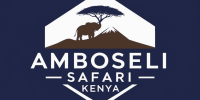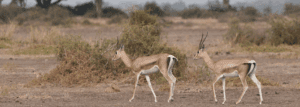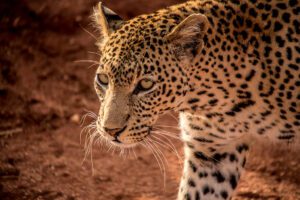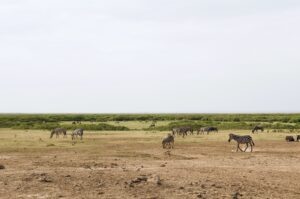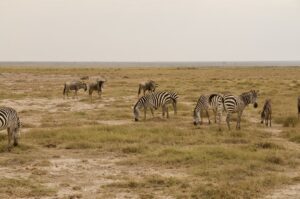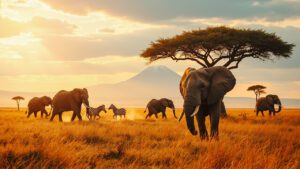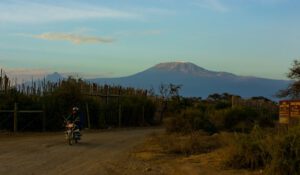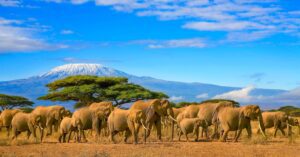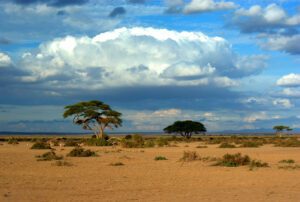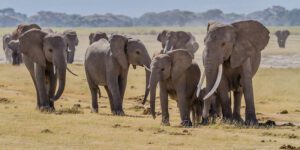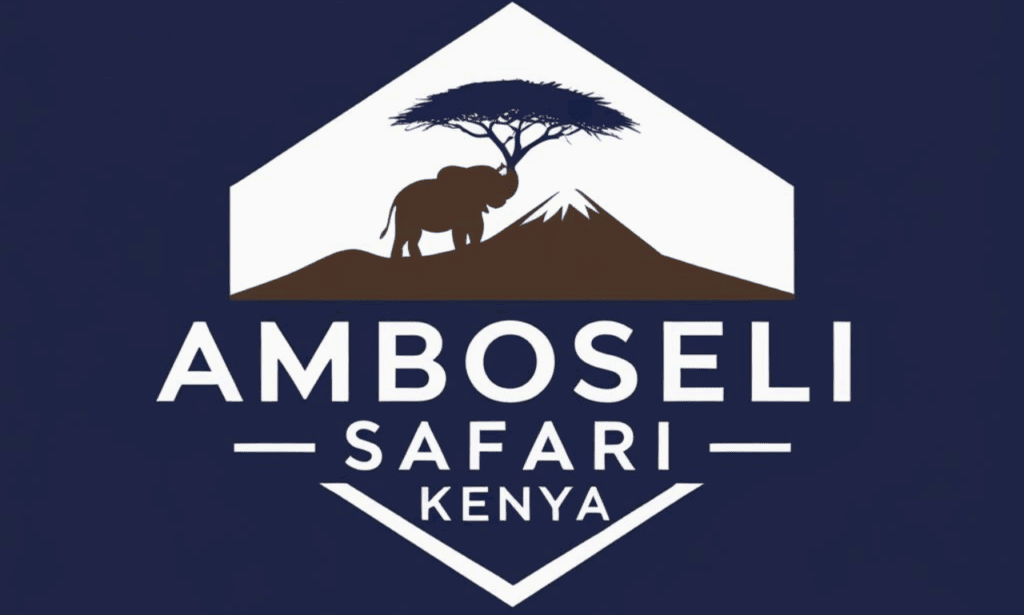What is Amboseli National Park, and where is it located?
Amboseli National Park is a well-known wildlife conservation area in Kenya, located in the southern part of the country near the border with Tanzania. It’s one of Africa’s most famous safari camping destinations, covering an area of 392 square kilometers (about 151 square miles). One of its most iconic features is Mount Kilimanjaro, the tallest mountain in Africa, which provides a stunning backdrop to the park. While Mount Kilimanjaro is technically in Tanzania, Amboseli offers some of the best views of this majestic mountain, especially during sunrise or sunset when the light makes Kilimanjaro appear golden and glowing.
The park is located in Kajiado County, about 240 kilometers (150 miles) southeast of Nairobi, Kenya’s capital. It is relatively easy to access by road or air, making it a popular destination for both domestic and international tourists. The name “Amboseli” comes from the Maasai word that loosely means “salty dust,” which hints at the unique ecosystem of the park. The landscape in Amboseli is a mix of dry, dusty plains and lush marshes that are fed by underground springs originating from Mount Kilimanjaro’s glaciers, making it an ideal spot for amboseli national park camping.
The park is part of a larger biosphere, meaning it’s not just about wildlife, it also includes the local communities, particularly the Maasai people, who have lived around the region for generations. Their rich culture adds to the overall appeal of visiting Amboseli. So in simple terms, Amboseli National Park is a place where you can see amazing animals, breathtaking views of Kilimanjaro, and connect with the traditions of the Maasai people.
What are the main attractions and unique features of Amboseli National Park?
Amboseli National Park is renowned for its incredible wildlife viewing, scenic landscapes, and cultural experiences. One of its most unique features is the consistent, clear view of Mount Kilimanjaro, which towers majestically in the background of the park. This iconic mountain is not just a beautiful sight; it creates an important water source for the park. As the snow on Kilimanjaro melts, it feeds underground rivers and springs that sustain the diverse wildlife in Amboseli. This mix of dry plains and wetlands fosters a special environment where numerous plants and animals thrive, making it one of the top national park camping destinations in Kenya.
Among the park’s most famous attractions is its large population of African elephants. Often referred to as the “Land of the Giants,” Amboseli is one of the best places in the world to see these magnificent creatures up close. The elephants here are quite relaxed around vehicles, allowing travelers to capture amazing views and photographs of them in their natural habitats, whether they’re playing in the water, caring for their calves, or grazing in the distance. This wildlife experience is enhanced by the availability of amboseli camping options, which provide an immersive experience in nature.
The swampy areas of Amboseli are another defining feature. These wetlands stand out in the middle of an otherwise dry, dusty landscape. You might see hippos lounging in the water or water birds like flamingos, herons, and pelicans nearby. Surrounding the park’s greenery are vast open plains and dry lake beds, like Lake Amboseli, which creates a dreamy, almost otherworldly effect with mirages on hot days.
Cultural experiences with the Maasai people are another unique highlight. Many visitors get to visit Maasai villages around the park and learn about their culture, traditions, and way of life. With activities like traditional dances or learning about Maasai beadwork, you come away with a better appreciation of the people who have lived near Amboseli for centuries.
What wildlife species can be spotted in the park?
Amboseli National Park is teeming with wildlife, making it a dream destination for animal lovers and safari enthusiasts. The park is especially famous for its African elephants, which you can see in large herds roaming the open plains or cooling off in the swamps. A visit to Amboseli also supports wildlife conservation efforts, as its elephants are among the most studied and protected in the world, making it a key location for amboseli national park camping experiences.
Beyond elephants, Amboseli is also home to the “Big Five” animals, though you might not spot all five depending on when you visit. The Big Five include lions, leopards, rhinos, elephants, and Cape buffalo. While lions are commonly seen lounging in the grass or hunting in the early morning, leopards are more elusive and difficult to spot. Rhinos are rare in Amboseli, but you still have a chance to see the striking African buffalo grazing alongside zebra and wildebeests.
Speaking of zebras and wildebeests, Amboseli has plenty of other grazers, like gazelles, elands, and impalas. These animals attract predators like cheetahs and hyenas, which are also present in Amboseli, so safari-goers often get to witness thrilling scenes of the predator-prey dynamic. The variety of wildlife adds to the allure of camping safaris in the area, where you can stay at various amboseli campsites.
If you enjoy bird-watching, Amboseli is also a paradise for you. With over 400 species of birds recorded in the park, you might spot flamingos, crowned cranes, ostriches, or eagles, just to name a few. Hippos can be seen in the swampy areas, often accompanied by water birds hunting for food, enhancing your wildlife experience while staying at the amboseli public campsite.
In short, when you visit Amboseli, bring your binoculars (or a good camera) because you’re in for an unforgettable wildlife spectacle! From large mammals to tiny birds, there’s always something fascinating to spot in this beautiful national park camping destination.
What camping facilities or designated areas are available in Amboseli National Park?
Amboseli National Park offers a variety of camping facilities designed to suit the needs of different campers, from budget travelers to those seeking unique wilderness experiences. The park features both public and private campsites, including options like Amboseli public campsite and Amboseli camp. Public campsites are open to all visitors, are more basic, and generally offer essential facilities. These may include pit latrines, basic showers, and areas to pitch a tent or park a camping vehicle. Examples of public campsites include camps like Kimana or Oleitoktok Hill, which allow you to immerse yourself in the natural beauty of the park.
For those seeking a more private experience, Amboseli also has special campsites, such as Porini Amboseli Camp. These are typically designated for one group or party at a time, ensuring exclusivity and a more intimate connection with nature. Special campsites are often less developed, meaning no fixed facilities like toilets or running water, but they allow visitors to truly feel like they are in the wild. To ensure sustainability and protect the park, these special campsites often require advance bookings and sometimes even ranger accompaniment.
In addition to these basic and private camping options, there are also luxury wildlife experience options nearby for visitors who want a more comfortable camping experience but still enjoy proximity to the park. These aren’t your standard campsites but more like eco-friendly lodges in tent form, offering beds, showers, dining areas, and sometimes even swimming pools.
Keep in mind that firewood collection and littering are not permitted to ensure the park’s delicate environment is conserved. Campers must be mindful of carrying their own supplies and leaving no trace.
Are there any regulations or permits required for camping in the park?
Yes, there are specific camping regulations and requirements you need to follow when camping in Amboseli National Park. To start, camping inside the park is regulated by the Kenya Wildlife Service (KWS), and you will need to pay both park entry fees and camping fees. These fees vary depending on the type of campsite (public vs. private) and whether you are a Kenyan citizen, an East African resident, or a non-resident tourist. For example, non-residents usually pay higher park and camping fees compared to local residents or citizens.
If you want to use one of the special campsites (which are more private and allow a remote experience), you generally need to book in advance and gain approval from the authorities. Advance bookings can be done either through KWS headquarters or other authorized bodies. Special campsites may also require you to pay additional fees due to their exclusivity and the limited number of campers allowed at a time.
Another important regulation is that all campers must abide by the park’s “Leave No Trace” policy. This means you’re responsible for taking all your trash out of the park to maintain its pristine environment. In addition, visitors are not allowed to collect firewood from the park, so you’ll need to bring your own fuel or use a gas stove for cooking. Campfires are often restricted to designated areas only.
Finally, staying at campsites inside the park may involve certain safety rules since you’re in a wildlife-rich area where animals like elephants or lions can roam freely. For example, at night, it’s advisable not to leave your tent unnecessarily, and it’s best to camp with a guide or ranger nearby. Always inquire about the latest rules when planning your trip.
What is the best time of year to visit and camp in Amboseli National Park?
The best time to visit and camp in Amboseli National Park is during the dry seasons, which typically occur from June to October and then again from January to February. These months are perfect for wildlife viewing and national park camping because the weather is more predictable, and conditions are generally favorable. Since Amboseli is a semi-arid area, rainfall during the wet season can make some roads within the park muddy and impassable, disrupting your camping plans at the amboseli public campsite.
During the dry season, the vegetation is less dense, making it easier to spot animals like the famous Amboseli elephants, lions, and cheetahs. This is especially true in June and July. The animals tend to gather around water sources, such as the park’s wetlands and marshes, making certain areas particularly rewarding for both game drives and nature walks. Clear skies during the dry season also mean you’re more likely to get stunning views of Mount Kilimanjaro, which forms the iconic backdrop to Amboseli.
The wet seasons, occurring from March to May (long rains) and November to December (short rains), are not as ideal for camping. During this time, the rains can make trails slippery, and some campsites could become inaccessible. Additionally, wildlife tends to scatter more because there are plenty of water and food sources everywhere, making animals harder to spot.
If you’re planning to camp at night, the weather during the dry season is also more comfortable, with cooler evenings and less humidity. However, be prepared for chilly nights, especially between June and August. Bringing warm sleeping gear is essential for a pleasant stay at the amboseli camp.
Ultimately, whenever you choose to visit, planning ahead based on weather patterns and seasonal park conditions is essential to having the best camping experience possible!
What safety precautions should be taken while camping in a wildlife-rich area like Amboseli?
Camping in a wildlife-rich area like Amboseli National Park, particularly at the Amboseli public campsite, is an incredible way to experience nature. However, safety needs to be a top priority because you’re essentially living among wild animals. Here are some simple but important safety tips to follow that will help keep you and the wildlife safe.
- Keep a safe distance from animals: Always maintain a large buffer between yourself and any wildlife you encounter, even if they seem calm. Animals in the park, like elephants, lions, or buffalo, are not tame. They can be unpredictable and might feel threatened if you get too close.
- Stay within designated camping areas: Amboseli has specific zones where camping is allowed. These areas are designed with both safety and conservation in mind. They may be patrolled by rangers, and the areas are chosen to minimize the chance of animal encounters while still allowing a wild experience.
- Avoid wandering at night: Many animals in Amboseli are more active after dark, and wandering outside your campsite can bring you dangerously close to predators like lions or hyenas. Always stay in your tent or designated sleeping area after sundown.
- Secure your food: Store food in sealed containers and never leave it out in the open. The smell of food can attract animals like monkeys, hyenas, or even larger creatures. You don’t want uninvited visitors raiding your camp looking for snacks.
- Bring proper lighting: Carry a strong flashlight or headlamp for nighttime use. It will make it easier to see your surroundings and spot any animals near your campsite.
- Follow park regulations: Amboseli has specific rules in place to ensure your safety, such as restrictions on fires, noise, and off-limit areas. Listen to the advice of park rangers and follow all posted guidelines.
- Be aware of your surroundings: Always pay attention to the environment, such as animal sounds or tracks near your campsite. These signs could indicate wildlife is nearby.
Example: Let’s say you hear the roar of a lion at night while in your tent. It’s essential to remain calm and stay inside your tent. Don’t attempt to leave or investigate. Lions usually avoid humans unless provoked, so staying put is the best strategy.
Being cautious while camping in Amboseli National Park not only ensures your safety but also protects the animals, contributing to wildlife conservation and maintaining the natural balance of the park.
What gear and supplies are recommended for camping in Amboseli?
When enjoying Amboseli national park camping, it is vital to pack the right gear and supplies to ensure comfort, safety, and preparedness for the unique environment of this great wildlife experience.
- A reliable tent: Choose a sturdy, weatherproof tent that can protect you from the hot sun during the day and potential rain at night (especially if you visit during the wet season). Make sure it has insect netting to keep mosquitoes and other bugs out.
- Sleeping essentials: Bring a comfortable sleeping bag suited for warm weather and a portable mat or air mattress. Amboseli can get chilly in the early morning hours, so a light blanket or liner is also a good idea.
- Clothing: Pack lightweight, breathable clothing for the day, but don’t forget a warm jacket or sweater for the cooler evenings. Long-sleeved shirts and pants protect against sunburn and insect bites. Neutral colors like khaki, green, or brown are best since they blend in with the environment.
- Cooking items: Carry a portable camping stove or burner, lightweight cookware (pots, pans), utensils, a cutting tool, and biodegradable dish soap. Avoid open fires except where permitted. Also, bring non-perishable food items like canned goods, rice, or high-energy snacks.
- Plenty of water and a filtration system: While camping, you’ll need to stay hydrated. Bring enough water for drinking, cooking, and cleaning, and consider packing a water filter or purification tablets in case you need more.
- Sunscreen, hat, and sunglasses: Amboseli is located in a hot, sunny climate, so sun protection is a must to avoid sunburn or heat-related issues.
- Bug spray and first aid kit: Protect yourself from insects with a quality repellent and have a well-stocked first aid kit for emergencies. This should include bandages, antiseptics, pain relievers, and medications for allergies or stomach issues.
- Binoculars and a camera: Amboseli is known for its wildlife. Binoculars will help you spot animals in the distance, like elephants around the watering holes, and a camera ensures you can preserve those memories.
- Power banks or solar chargers: Since you’re unlikely to have access to electricity, portable chargers or solar panels can keep your phone or camera powered.
- Maps and a guidebook: A detailed map of the park or a GPS device is useful for navigation. A guidebook can also help you learn more about the animals and habitats you might encounter.
Example: Imagine waking up to the sunrise over Mount Kilimanjaro and realizing your hat and sunscreen are forgotten, you’ll quickly feel the harsh effects of the sun. Packing these essentials ensures you can enjoy the experience without discomfort.
By being prepared with the right gear, you can fully enjoy the beauty of Amboseli National Park camping without unnecessary challenges.
Are guided camping services or ranger assistance available in the park?
Yes, Amboseli national park camping offers guided camping services and ranger assistance, enhancing your experience in this great wildlife experience and making it much safer and more enjoyable.
Guided Camping Services
Guided camping services are an excellent option for visitors new to Amboseli or those who want a stress-free and immersive experience. These services typically provide all the logistics, including setting up tents, cooking meals, and interpreting the surrounding environment. A guide will take you on game drives to see wildlife like elephants, lions, and cheetahs while sharing expert knowledge about the local ecosystem and Maasai culture.
Some guided tours include luxury camping with pre-constructed tents, comfortable beds, and gourmet meals prepared on-site. This is a convenient choice for visitors who want to enjoy the wild without sacrificing comfort.
Ranger Assistance
Park rangers in Amboseli are trained professionals who monitor the area for safety and conservation purposes. They know the terrain extremely well and can share valuable advice on camping safely in the park’s wildlife environment. In some cases, rangers might be stationed near campsites or may escort groups to ensure their safety.
If you are camping without a guide, you can still request ranger assistance if you’re uncertain about safety or want additional insights into the park. They can advise on where to set up camp, what animals to look out for, and how to minimize risks.
Example: Let’s say you want to spot Amboseli’s famous elephants but aren’t sure where the herds are likely to be. A guide will take you to the best spots and explain their behavior, while a ranger can help ensure the area is safe for close observation.
Using guided services or having a ranger’s help can enhance your Amboseli national park camping experience, taking the guesswork out of your trip and allowing you to relax amidst the breathtaking landscape!
How accessible is Amboseli National Park, and what transportation options are available to get there?
Amboseli National Park is located in southern Kenya, near the border with Tanzania, and is fairly accessible by road and air. The park is about 240 kilometers (around 150 miles) from Nairobi, Kenya’s capital city, making it one of the more popular wildlife destinations in the country due to its proximity to Mount Kilimanjaro. For those interested in Amboseli camping, the park offers several options, including Amboseli public campsite and private campsites for a unique experience.
For those traveling by road, you can drive from Nairobi to Amboseli, which takes roughly 4–5 hours depending on the route and road conditions. The most common route is via Namanga, a town on the Kenya-Tanzania border, which involves driving through a mix of tarmac highways and a few bumpy roads closer to the park. This is a great choice if you like scenic road trips, as you’ll see local villages, open plains, and eventually the iconic view of Mount Kilimanjaro looming in the distance. It is recommended to use a sturdy 4×4 vehicle, especially during the rainy seasons when the roads inside and around the park can get muddy.
Alternatively, if you’re short on time or prefer convenience, there are domestic flights available. Small chartered planes or scheduled flights by companies like Safarilink and Air Kenya can take you from Wilson Airport in Nairobi to the Amboseli airstrip, located near the park. The flight takes just under an hour, making it an efficient way to travel. Many travelers opt for safari camps that provide a luxury wildlife experience, enhancing their visit to Amboseli.
Once you reach Amboseli, transportation within the park is often done in safari vehicles, which are usually open-roofed for excellent wildlife viewing. Various tour operators in Kenya provide packages that include transportation to and within the park. If you’re a first-time visitor, hiring a guide or joining a group safari can help you get the most out of the experience, especially when exploring the rich biodiversity that Amboseli National Park caters to.
In summary, Amboseli is accessible by road for those who enjoy driving and scenic views, and by air for travelers seeking a quicker option. Inside the park, safari vehicles offer the best means of transportation for exploring the wildlife and landscapes, making it a must-visit destination for nature lovers.
What cultural or local experiences can be explored while camping near the Maasai communities?
Camping near Maasai communities in and around Amboseli National Park offers a unique opportunity to immerse yourself in one of Kenya’s most iconic and traditional cultures. The Maasai people are known for their vibrant customs, colorful clothing, and close connection to nature, making them an integral part of the Amboseli camping experience.
Visitors can engage in guided cultural tours to Maasai villages, often called “manyattas.” In these villages, you’ll have the chance to interact with locals and learn about their traditional way of life. For example, you might see how the Maasai construct their homes, called “enkangs,” using natural materials like mud, sticks, and cow dung. You might also witness cultural practices such as traditional dances and ceremonies, which often feature rhythmic chanting, powerful jumping (a signature of Maasai warriors), and vibrant attire adorned with beadwork. These dances are usually a celebration of communal life or signify important events like marriage.
You’ll also learn about the Maasai diet and their reliance on livestock like cattle, sheep, and goats. Milk and meat play an important role in their cuisine, and sometimes you may even witness the customs surrounding their care for animals or their survival techniques in the harsh savannah environment, especially in areas outside Amboseli National Park.
Additionally, the Maasai are skilled artisans, and many visitors enjoy purchasing handmade beadwork, jewelry, and carvings directly from the community. This not only provides you with beautiful souvenirs but also supports the local economy, particularly when visiting Amboseli campsites.
Keep in mind that while visiting Maasai villages, it’s important to respect their culture and traditions. Always ask for permission to take photos and be mindful of engaging with their customs in a polite manner.
In conclusion, camping near Maasai communities allows you to discover a rich cultural heritage that enhances your Amboseli adventure. It’s not just about the park’s iconic wildlife, but also about connecting with Kenya’s incredible people.
What are the environmental and conservation considerations for campers visiting Amboseli?
Amboseli is a stunning natural environment, home to a delicate ecosystem that needs to be conserved for future generations. As a camper, respecting the environment is crucial to preserving this precious wildlife haven. Here are some key environmental and conservation considerations to keep in mind when visiting:
- Leave No Trace: This is a golden rule for any camper. Do not leave behind trash or disturb the natural landscape. All your waste should either be properly disposed of in designated bins provided within the park or taken with you when you leave. For example, plastic bottles, food wrappers, or cans can harm animals if left unattended.
- Minimize Noise & Respect Wildlife: Amboseli is home to elephants, lions, giraffes, zebras, and many other animals. Loud noises, music, or sudden movements can disturb the wildlife. Always maintain a safe and respectful distance when observing animals and never attempt to feed or provoke them.
- Stick to Designated Areas & Roads: Ambush-style, off-road excursions are harmful to the environment. Driving or walking off marked paths can damage vegetation and disrupt animal habitats. Always follow the park’s rules and stay on designated routes.
- Use Sustainable Camping Practices: If you’re camping overnight, ensure that you use eco-friendly gear and supplies. For instance, avoid disposable plastics and instead bring reusable items like water bottles and utensils. If cooking, use fuel-efficient stoves instead of open fires, which can pose a risk to the dry environment.
- Respect Water Sources: Amboseli’s wetlands and springs, fed by Mount Kilimanjaro, are vital for the survival of animals. Campers must avoid polluting or wasting water. For example, do not bathe or wash items in natural water bodies.
- Support Conservation Efforts: By visiting Amboseli, you are often contributing to conservation through park entry fees, which help fund anti-poaching projects and wildlife research. To further support, you can choose to stay with eco-friendly lodges or buy goods from local Maasai communities.
- Educate Yourself: Before visiting, learn about Amboseli’s unique challenges, such as human-wildlife conflict and climate change’s impact on the ecosystem. Being informed helps you make more responsible choices during your trip.
In short, environmental conservation in Amboseli isn’t just the park’s responsibility, it’s also the obligation of every visitor. By practicing these sustainable habits, you help protect Amboseli’s delicate balance of wildlife, landscapes, and local communities for years to come.
